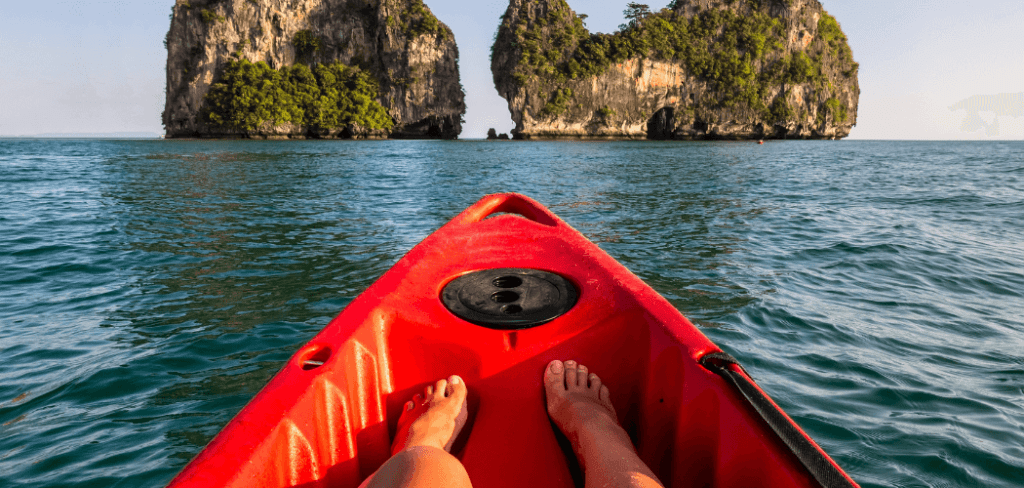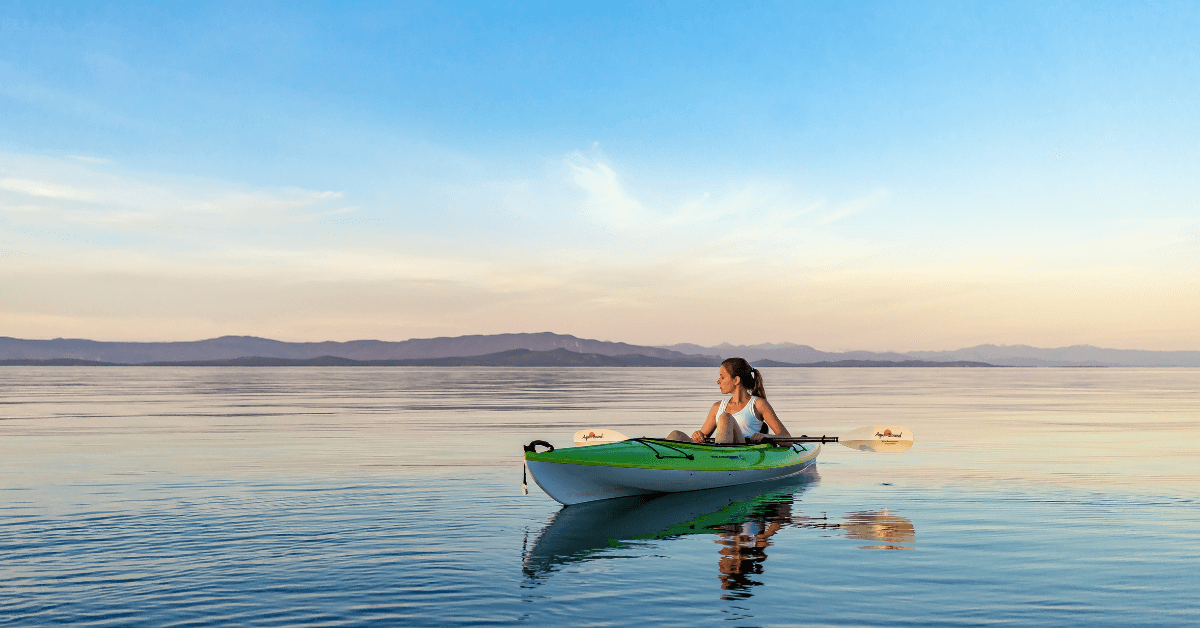Kayaking is a popular outdoor activity that offers a unique way to explore the natural beauty of lakes, rivers, and oceans. Not only is kayaking a fun way to enjoy the outdoors, but it also provides a great workout for your entire body, especially your legs.
If you’re wondering if kayaking is an effective way to work your legs, the answer is a resounding yes! In fact, kayaking can work your leg muscles even more than you might realize. But, let’s take a closer look at the mechanics of kayaking to understand why.
When you’re kayaking, your legs play a crucial role in maintaining stability and propelling your kayak through the water. Whether you’re paddling through calm waters or challenging rapids, your leg muscles are working hard to keep you balanced and moving forward.
So, let’s dive into the mechanics of kayaking and explore how this exciting outdoor activity can work your leg muscles like no other!
The Mechanics of Kayaking
When you’re kayaking, your entire body is working to keep you moving through the water. However, the leg muscles play a crucial role in maintaining stability, steering the kayak, and propelling it forward. Here’s a breakdown of how kayaking works your leg muscles:
1. Stabilizing your kayak
Your legs are responsible for maintaining balance and stability while kayaking. As you paddle, your legs are pressed against the footrests, which helps keep your body stable and prevents the kayak from tipping over. This constant pressure on your legs provides a low-intensity workout that helps build leg endurance.
2. Steering the kayak
To steer your kayak, you use a combination of upper body and leg movements. When you want to turn left, you lean your upper body to the right and use your left foot to apply pressure to the left pedal, which turns the kayak to the left. This movement works your inner thigh muscles and helps to build strength in your legs.
3. Propelling your kayak forward
When you’re paddling your kayak, you’re using your leg muscles to push against the footrests, which generates the power to move the kayak forward. Your leg muscles, particularly your quadriceps and glutes, are working hard to propel the kayak forward and maintain a steady speed. This action helps to build leg strength and endurance.
Do Kayakers Have Strong Legs?
It’s no secret that kayaking is a physically demanding activity that requires strength, endurance, and balance. And while kayaking works your entire body, the leg muscles are particularly important for stability and propulsion.
So, do kayakers have strong legs? The answer is a resounding yes! Kayaking is an excellent way to build leg strength and endurance, and many kayakers have developed impressive leg muscles as a result.
When you’re kayaking, you’re using your leg muscles to maintain balance, steer the kayak, and propel it forward. This constant use of your leg muscles helps to build strength and endurance, especially in your quadriceps, hamstrings, glutes, and calf muscles.
In fact, kayaking is often recommended by physical therapists as a low-impact exercise that can help with rehabilitation after leg injuries or surgeries. It’s also a great way to build leg strength and endurance for other activities like hiking, running, and cycling.
But don’t just take our word for it. Many professional kayakers have impressive leg muscles that are a testament to the strength-building benefits of kayaking. So, if you want to develop strong, powerful legs, grab a kayak and hit the water!
Why Do My Legs Hurt After Kayaking?

If you’re new to kayaking or have recently increased the intensity or duration of your kayaking workouts, you may experience some muscle soreness in your legs. But why do your legs hurt after kayaking? Let’s dive in.
1. Muscle Fatigue
Kayaking is a physically demanding activity that requires a lot of energy and effort from your leg muscles. If you’re not used to this type of exercise, your leg muscles may fatigue quickly, leading to soreness and discomfort.
To combat muscle fatigue, it’s essential to start with shorter kayaking sessions and gradually increase the duration and intensity over time. It’s also important to rest and allow your muscles to recover between kayaking sessions.
2. Dehydration
Dehydration can also contribute to muscle soreness and cramping after kayaking. When you’re kayaking, your body is working hard to regulate its temperature and stay hydrated. If you’re not drinking enough water, your muscles may become dehydrated, leading to soreness and discomfort.
To prevent dehydration, make sure to drink plenty of water before, during, and after kayaking. You may also want to consider bringing along an electrolyte replacement drink to replenish lost minerals and nutrients.
3. Poor Technique
Finally, poor kayaking technique can also contribute to leg soreness and discomfort. If you’re using improper technique or positioning, you may be putting unnecessary strain on your leg muscles, leading to soreness and fatigue.
To improve your technique and prevent leg soreness, consider taking a kayaking class or working with a professional kayaking instructor. They can help you refine your technique and positioning to reduce the strain on your leg muscles and prevent soreness and discomfort.
How to Improve Leg Strength for Kayaking
Kayaking requires a lot of leg strength to paddle effectively and maneuver through the water. If you’re looking to improve your leg strength for kayaking, here are some tips to help you get started.
1. Squats
Squats are a great exercise for building leg strength, especially in the quadriceps and glutes. To perform a squat, stand with your feet shoulder-width apart, bend your knees, and lower your hips down as if you’re sitting back into a chair. Then, push back up through your heels to return to a standing position. Aim for three sets of 10-15 reps.
2. Lunges
Lunges are another effective exercise for building leg strength, particularly in the quads, hamstrings, and glutes. To perform a lunge, step forward with one foot and bend both knees, lowering your back knee down toward the ground.
Then, push back up through your front heel to return to a standing position. Repeat on the other side. Aim for three sets of 10-15 reps on each leg.
3. Plyometrics
Plyometrics, also known as “jump training,” can be an effective way to improve leg strength and power for kayaking. Some examples of plyometric exercises include box jumps, jump squats, and jump lunges. These exercises can be challenging, so be sure to start with lower boxes or modifications if needed.
4. Cardiovascular Exercise
Cardiovascular exercises, such as running, cycling, or swimming, can also be beneficial for improving leg strength and endurance for kayaking. Aim for at least 30 minutes of moderate-intensity cardiovascular exercise three to four times per week.
5. Kayaking Practice
Finally, the best way to improve your leg strength for kayaking is to kayak regularly! Make sure to include a variety of kayaking workouts in your routine, including shorter, high-intensity sessions and longer, endurance-based sessions.
Gradually increase the duration and intensity of your kayaking workouts over time to continue challenging and strengthening your leg muscles.
Related: How To Build A Shelter On An Island
Final Thoughts – Does Kayaking Work Your Legs?
Yes, kayaking can work your legs, especially the muscles in your thighs, hips, and calves. The leg muscles are involved in stabilizing the kayak, paddling, and maintaining proper body position while on the water, making kayaking an excellent low-impact workout for the lower body.
If you’re experiencing leg pain after kayaking, don’t worry; it’s a common issue that can be alleviated with proper stretching and recovery techniques. And if you’re looking to improve your leg strength for kayaking or any other activity, there are many exercises you can incorporate into your routine.
So, if you’re looking for a fun and challenging way to work your legs while enjoying the great outdoors, give kayaking a try! Just remember to stay safe, have fun, and appreciate the beauty of nature. Happy paddling!
